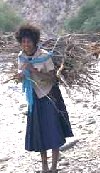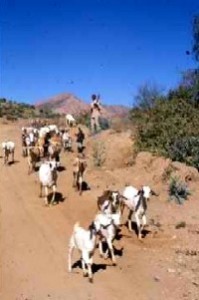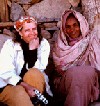First published in Habitat Australia, 1989.
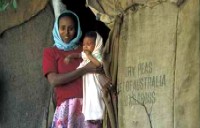
The cost of war: an orphaned child is cared for by a young fighter in a nursery constructed from bags labelled 'Gift of Australia'. Photo by Merrill Findlay, 1988.
Take one small strategically placed former Italian colony, deny its four million people education, health care and their right, under international law, to self-determination; give it no military assistance but let both East and West supply its adversary with military and/or economic aid; bombard it, attempt to starve it, degrade and deforest it – and what do you have?
Against all odds, you have one of the world’s most remarkable social transformations being effected by arguably the world’s most sophisticated liberation movement, the Eritrean People’s Liberation Front.
Eritrea, the scene of this miracle, is a narrow strip of land wedged between Sudan, Djoubouti, Ethiopia and the Red Sea Its colonial borders were defined under international law one hundred years ago during the great European land grab in Africa. By some accident of history, Italy claimed it then. Later, after Mussolini’s defeat in Africa, Great Britain administered it. Now Ethiopia claims it. But all the Eritrean people want is their right to decide their own future – and they’ve been fighting for that right of self-determination for twenty-seven years.
The commitment to a free Eritrea runs deep. Tecle Frezghi, my companion on my recent trip into Eritrea, for example, gave up his postgraduate course in organic chemistry in the United States to join the liberation movement. Like many Eritrean intellectuals abroad, he says he just couldn’t bear to remain away knowing his country needed him. He participates in the struggle from behind a desk now, as a senior bureaucrat within the EPLF, but carries many scars from his fighting days. Brhana, his wife, a young doctor trained by the EPLF’s Department of Health, works behind enemy lines on the western front. They see one another rarely. But this is the price individuals must pay for national self-determination, and they pay willingly. The military struggle is fundamental to everyone’s life in Eritrea.
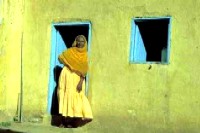
The other side of the war: a mother who fled with her children to a refugee camp in Sudan. Photo by Merrill Findlay, Kassala, Sudan, 1988.
As we drove across the arid mountains at night and in the early hours of the morning to avoid aerial attack, Tecle repeatedly asked our young driver to stop the vehicle so he could tune in to the faint Voice of the Masses, the EPLF’s radio frequency, for an update on the fighting. The progress of the latest battle near the road between the port of Massawa and Asmara, the capital city, was on everyone’s lips. (A whole Ethiopian division was being defeated by the EPLF in a small but meticulously planned tactical offensive.) And the signs of militarisation were everywhere: tanks parked under acacia trees; convoys of trucks loaded with heavy artillery shell casings going to the metal workshops to be melted down and recycled; hidden anti-aircraft guns; underground workshops where the captured Soviet tanks, trucks etc were being repaired; orphaned children and disabled combatants.
Nearly every night we gave lifts to young fighters, both men and women, going to or from, the front. As they seated themselves beside me in the 4WD, they tenderly cradled their captured Soviet-made kalashnikov rifles on their laps and wrapped them in their kashooks, the long cotton garment that is usually worn either around the head or around the waist.
One day Tecle and I sat together on a rock in the sun overlooking a quiet, rural valley dotted with juniper trees and native African olives. “This is a good place for a battle,” he commented as we gazed across the rocky slopes of Rora Hubub. “If we’d been able to fight here instead of on the open plains, the war would have been over years ago.”
I could see what he meant. The scene was a military strategists’ dream. But my spirit protested. This lovely place a war zone?
In a sense, this peaceful Rora plateau is already a “war zone”, because in Eritrea, militarist language has been appropriated by the social engineers. For here, according to Andrebrhan Welde Giorgis, the Harvard educated Director of Education and member of the EPLF’s Central Committee, “the war against illiteracy, against ignorance, against disease, against backwardness” is being waged. In this “war”, the front line is in every Eritrean community and on every degraded mountain slope, valley or field.
If the military conflict is a struggle for self-determination, then this parallel “war” is a struggle for what, in the Hegelian sense, could be called self-realisation; a social revolution that is transforming what was predominantly a feudal, illiterate, agrarian and generally very poor population into a literate, democratic society which will, one day, be able to define its own future and sustain itself culturally, economically and ecologically as a self-sufficient and independent nation state. All the political, economic, social and indeed, military decisions of the EPLF are made with this long term vision in mind.
The effect on people’s lives of this apparently peaceful revolution, or parallel “war” of self-realisation, cannot be underestimated.
At one tiny timber and mud brick school in the Rora Hubub region, not far from where Tecle and I had sat on our rock and talked military strategies, a young teacher, Alefesh Asfarha, curled up on my borrowed bed in the principals office one night and, in a gentle whisper (and perfect English), told me how, at just fifteen, she had run away from occupied Asmara “to fight for my country.”
Now, at 21, having completed her secondary education at Zero School (the EPLF’s boarding school for 4,000 students hidden in an arid, rocky valley) plus ten weeks teacher training with the Education Department, she is liberating her country not with a kalishnikov, but a blackboard. Her students, both young and old, sit on rocks in their brand new class rooms and learn about a world they never knew existed until this young teacher and her colleagues arrived.
Each year, for hundreds, perhaps thousands of years, the Rora Hubub families had lived the semi-nomadic existence of agro-pastoralists, moving with their stock between the lowlands and this plateau region. Here they would stop awhile, erect their black tents and plant their traditional crops, then, as surface water dried up, move on again with their animals. They had no access to health care beyond their own traditional practices, no education beyond what they passed on orally from generation to generation; no roads nor other services. And if the rains failed, if their stock died or were stolen or killed by the Ethiopian army …
In 1986, following the 84/85 drought crisis that displaced thousands of Rora Hubub’s seasonal residents, life began to change. For it was in that year that the EPLF, with humanitarian finance raised by the Eritrean Relief Association (an indigenous non-governmental aid organisation), began its integrated rural development program for the region. The revolution had arrived, and slowly life was transformed in Rora Hubub. For the first time there were roads, schools, clinics, and, most fundamental of all, dams to provide a year around water supply.
“Availability of the drinking water supply has been a serious problem in the area, so we are trying to provide the people with drinking water for themselves and their livestock,” explained ERA’s field co-ordinator, Gabramichael Menghistu.
“This will enable women to stay in the rural area even in the winter time and also help the people who would like to send their children to school to stay there. Without the water supply that we have started providing them, this would not have been possible. Most of the people normally leave the district simply because they cannot get drinking water,” he told me.
Once the basic needs of the people were met, consideration could be given to improving long-term agriculture and animal husbandry practices to raise productivity and stop environmental degradation.
And the degradation is excessive. Every mountain slope tells the story of despair, of long years of drought when the African olives trees meant the difference between life and death for hungry pastoralists who lopped them to feed their starving stock, and hence, themselves. Many of the trees never recovered – though the people survived. Just.
With the trees and grass cover gone, the soil on the steep slopes simply washed or blew away. Hungry goats, sheep, cattle and camels meant natural regeneration was impossible.
“Now we are trying to make the people aware of the need for reforestation,” Gabramichael continued. ” Because without the participation of the people, and without making the people aware of the need for re-afforestation, any re-afforestation or soil and water conservation cannot work. We believe that by showing them in practice what it means then we are raising the awareness of the people and eventually it will be sustained development — because of the participation of the people. So the whole approach is to make the people aware and to hand over the management of the program to them.”
“And the people have started to benefit from the program now,” Gabramichael continued, “by the supply of drinking water, cash money, and they have even started to realise that the fertility of the fields that have been terraced is higher than those not terraced. So now they have really started to internalise it, you know, to appreciate the changes, and associate themselves with the program.”
As Regbe Bayre, a once illiterate young mother, told me (through a translator) as we sat together in a stone cottage surrounded by juniper trees: “When we were leading a nomadic life, we did not have education and we did not know anything. We were only able to temporarily solve the problems of our daily life. Here we have gained education and we have been working on our land. Our land is now enriched and is giving us produce. And our children have been saved from the hardships they suffered before.”
Here in Rora Hubub, the “war” against illiteracy, drought, deforestation, land degradation, poor health, isolation and all the other factors that have maintained Eritrea’s Third World status is being won. The victory can be measured in tangible terms – like improved crop yields, surplus food production, an emerging cash economy, healthy kids, reduced infant and maternal mortality, access to permanent water, grain mills, terraced wood lots of eucalyptus and nurseries for indigenous species – and men and women who were once illiterate, hungry and vulnerable, now taking control of their lives, of their future.
But in the real war, the struggle for national liberation that rages only hours by mountain track from peaceful Rora, young men and women, both Eritreans and Ethiopians, continue to die. Resources that could be used to transform and enrich the lives of all people throughout the Horn of Africa, are being used to kill, maim and destroy, in this, one of the poorest parts of the world. And the world remains silent.
“It’s the world who should be responsible,” Dr Abrahet, a women who is daily saddened and angered at the price her people must pay for this long war, told me at her small stone clinic at the EPLF’s Central Hospital at Orotta. “We cannot say East or West – we give this to all the world. And they should at least try to open their eyes to see what is going on. Open their ears to hear what is happening.”
Says Dr Abrahet, “Such things are happening because the world has turned a deaf ear to the Eritrean question.”
Brief history of the military conflict in Eritrea
The current military conflict in Eritrea had its genesis four decades ago, in 1949, when the international community considered the future of Italy’s former African colonies in the fledgling United Nations. Somalia and Libya were offered independence, but little Eritrea, that strip of land on the Red Sea within cooee of the Middle East, the Arabian Peninsular and the Suez canal, with its long-established deep-water port and scatter of islands that would make such excellent military bases, was considered much too valuable to be free.
Instead of independence, Eritrea was granted a United Nations Commission of Investigation to, amongst other things, “examine the question of the disposal of Eritrea” and to “ascertain more fully the wishes and best means of promoting the welfare of the inhabitants…”
Various and conflicting proposals were presented to the General Assembly, but, given the politics of the time, it is hardly surprising that the US sponsored Resolution 390 (A)V, was carried in 1952. As then US Secretary of State, John Foster Dulles, said: “From the point of view of justice, the opinions of the Eritrean people must receive consideration. Nevertheless the strategic interests of the United States in the Red Sea basin and consideration of security and world peace make it necessary that the country has to be linked with our ally, Ethiopia.”
So – justice was never done in Eritrea, and the opinions of the people were never considered (though both British and US surveys indicated that a majority clearly wanted independence). Eritrea was federated as an autonomous state with Emperor Haile Selassie’s feudal and landlocked empire.
Not unexpectedly, Ethiopia violently annexed Eritrea as its fourteenth province in 1962, in complete disregarded of the provisions of Resolution 390 (A)V and of the Eritrean constitution.
By this time, the inevitable armed struggle for self determination had already began. And though, for political reasons, the resulting conflict has never been widely recognised as a legitimate war of liberation under international law relating to decolonisation, it can clearly be interpreted as such.
From the Ethiopian point of view (both under Haile Selassie’s regime, and that of the Soviet Union’s current ally, President Menghistu), the hundreds of thousands of civilians and combatants involved in this liberation movement are merely “secessionist bandits”, “shiftas” or “counter-revolutionaries.” To the Ethiopians, the war is simply an “internal matter”. Thus any attempt to intervene or seek a political resolution is viewed as a threat to Ethiopia’s national sovereignty.
Officially the Australian government supports the Ethiopian view, though there is increasing recognition that, because of Eritrea’s colonial history, the war can be considered an international conflict and a case of incomplete decolonisation.
The Eritreans have now been fighting for twenty-seven years. Their army is made up of unpaid volunteers and their weapons are captured. While they have clear military superiority on the ground, they are not yet in the position to effect a definitive military resolution to the conflict – mainly because they do not have an airforce. Both EPLF combatants and Eritrea’s civilians remain vulnerable to bombing and napalming from Soviet supplied MiG fighters and helicopter gunships.
Recent information suggests that Ethiopian military capacity is being supplemented by hardware supplied by the United States of America and West Germany, as well as from the Eastern Bloc. A senior EPLF spokesperson told me recently that the US has supplied at least two Lockhead C130 aircraft, which are designed to carry military freight (tanks etc) and troops, while at least two landing craft have been received from West Germany. The same source said that the Ethiopian government had approached Britain to supply arms – with the encouragement of the USSR! Such are the complexities of this war.
To most informed observers it is clear that the conflict can only be resolved by either direct political pressure from the Soviet Union or by diplomatic intervention of the international community through a now much more mature United Nations system. Peres de Ceullar, the Secretary General of the UN, indicated last November that this may be possible. In such a diplomatic resolution to the conflict in Eritrea, Australia may well have a role to play.
STOP PRESS: Eritrea won its independence in 1992, but not at all in the way I expected in 1988. mf
Disclosure: I visited Eritrea as what we would now call an embedded journalist with the Eritrean People’s Liberation Front, which means that I only saw one side of this war. There were, however, many sides to this struggle.
© This material is subject to copyright and any unauthorised use, copying or mirroring is prohibited.
Content migrated to this new site on 5 December 2010. Page last revised 4 Febraury 2011.

